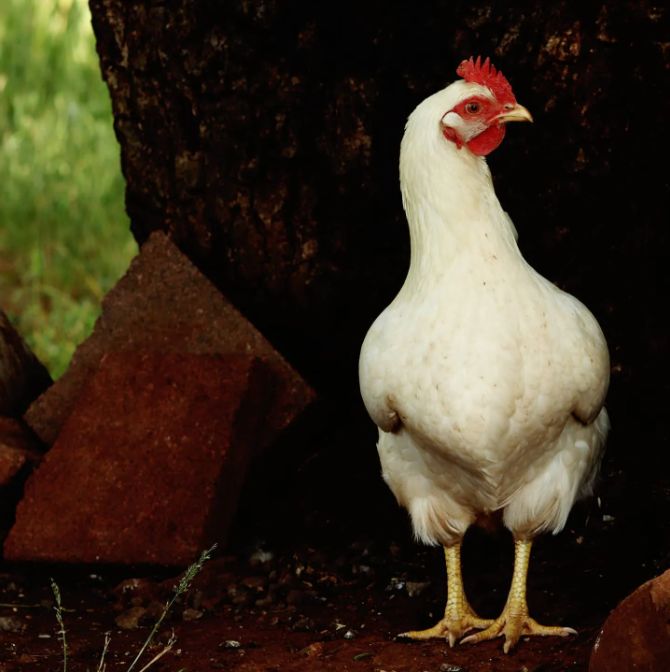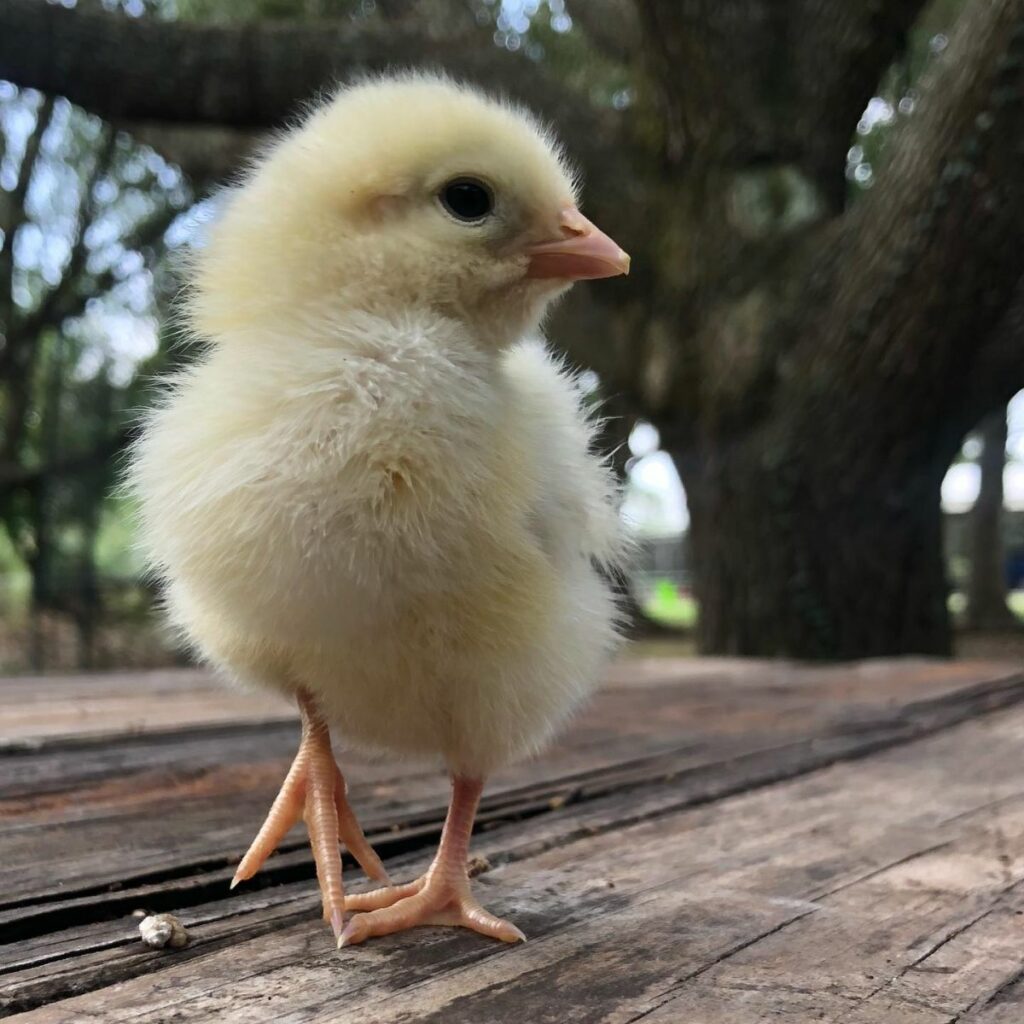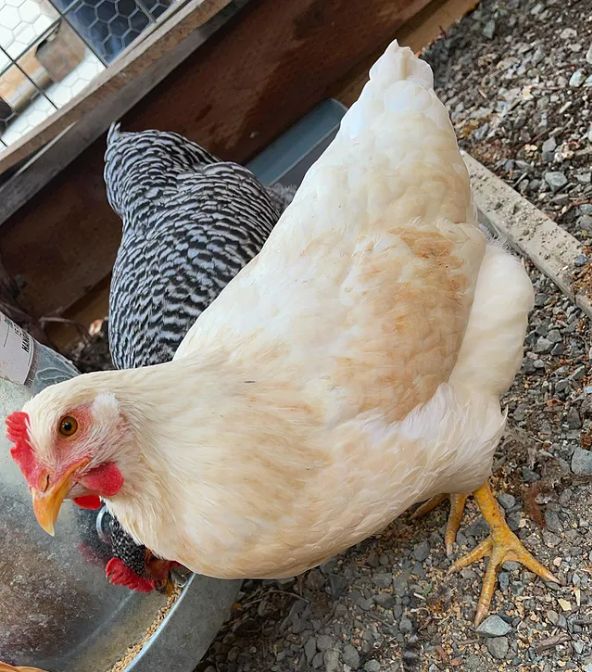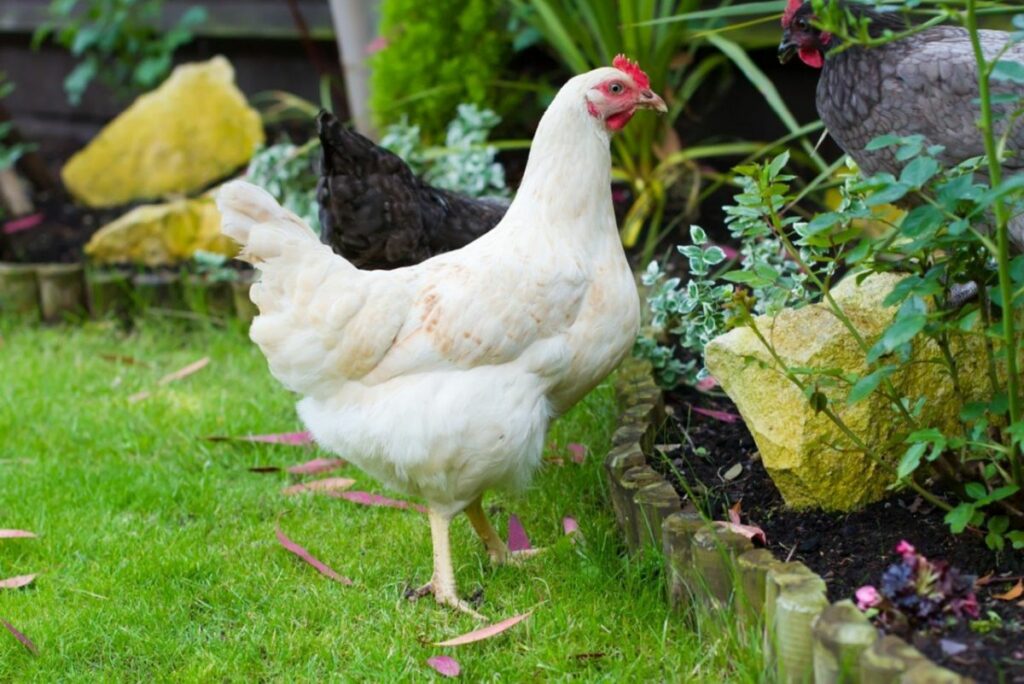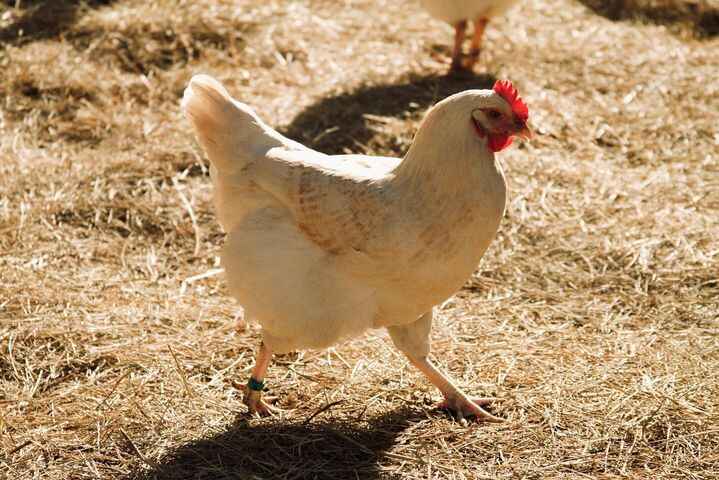The Amberlink chicken is a unique hybrid breed that’s known for its great egg production and beautiful white/amber feathers. However, hybrid chickens have a lot of concerns that keepers need to consider before buying these birds.
So, are you ready to care for Amberlink chickens and similar hybrid breeds? Let’s take a look at what their care entails.
Amberlink Chicken Overview
Before we cover the details of this unique hybrid breed, here’s an overview of its charactertistics.
| Lifespan | 3 to 4 years |
| Weight | 4 to 6 pounds |
| Appearance | White feathers with tints of amber |
| Egg Production | 270 per year |
| Egg Color | Brown |
| Good for Beginners? | Yes |
| Minimum Habitat Size | 4 square feet per bird inside coop, 10 outside |
| Price | $2 to $5 per chick |
Amberlink Chicken History
Technically, Amberlink chickens aren’t a breed, but instead, they’re a hybrid. These chickens were originally created by mixing a Rhode Island Red with an ISA Brown. Yet, they can also be created by using white Plymouth Rock chickens instead, which is the more common option today.
Yet, not every one of these breeding pairs will create an Amberlink. Sometimes, the chicks will become one of the parent breeds. So, there’s only a 50/50 chance that you’ll get Amberlink chickens. Even if you breed two Amberlinks together, you’re not guaranteed to get Amberlinks. Genes are complex and random, so they don’t always give the same results when breeding two different breeds.
Amberlink Chicken Lifespan
Sadly, hybrid chickens don’t live as long as purebred chickens. Purebred chickens often live around 8 years, but hybrids only live about half that long. So, you can expect your Amberlink chickens to live only around 3 to 4 years.
Appearance
These chickens can sometimes be tricky to distinguish from other white-feathered breeds. So, here’s what they look like at every life stage.
Amberlink Chicken Eggs
The Amberlink chicken egg color is brown. These eggs can be a variety of shades of brown, but medium to dark brown is most common. They lay large eggs that are perfect for using in egg recipes.
Amberlink Chicks
Whether your Amberlink baby chicks are male or female, they’ll be covered in fuzzy yellow feathers. So, it’s difficult to determine the sex of an Amberlink chick before they’re a few weeks old.
Pullets and cockerels, which are like teenage hens and roosters, start to appear more like adults as they get bigger. They’ll start to gain amber flecks in their feathers. The males will be more noticeably amber, with color appearing on their neck and back first.
Amberlink Chicken Color for Adults
From a distance, these chickens look like they have pure white feathers like Delaware chickens. However, if you look at them more closely, you’ll notice that they have flecks of color too. Their white feathers have a hint of amber-like coloring in them, hence the name of the hybrid.
Like pullets and cockerels, the color patterns vary between hens and roosters. Female chickens have more noticeable color flecks on their wings and tails while males are more likely to be colorful on their necks and backs.
Amberlink Chicken Size and Weight
These birds are considered medium-sized chickens, and the females are larger than males so they can produce lots of eggs. Hens usually weigh about 6 pounds while roosters are closer to 4 or 5 pounds.
Unfortunately, hybrid chickens can be unpredictable though. Some might be much larger or smaller than this general range. Yet, even though they’re mixed with hefty birds like Rhode Island Reds, they usually don’t gain that trait from them. Smaller sizes are one of the downsides of hybrid birds.
Temperament
Luckily, Amberlink chickens usually inherit a great personality, which is why they’re ideal for new chicken keepers. They’re considered friendly, gentle, and playful. All the potential parent breeds for these hybrids are usually friendly and easygoing, so that’s why Amberlinks are likely to behave well.
Are They Broody?
No, Amberlinks are rarely broody. Hybrid chickens are bred to be able to mass-produce eggs, so they won’t take the time to incubate their own eggs and care for chicks. It’s possible for an Amberlink hen to have some broody behaviors, but most hybrids never have an instinct to brood.
So, if you’d like to raise chicks, Amberlinks aren’t the best chickens for the job. If one of your birds lays fertilized eggs, you’ll need to incubate and hatch the eggs yourself.
Can They Live with Other Birds?
Since these hybrids are such friendly birds, they get along well with other animals. So, you can keep them in the same enclosure as other birds if you’d like. However, since they’re docile, they can easily get picked on by more dominant chickens. To protect them, it’s best to house them with other docile chickens.
Here are a few breeds that can live with Amberlinks:
- Rhode Island Red
- Silkie
- Plymouth Rock
- Cochin
- Speckled Sussex
- Buff Orpington
Care Requirements
Even though these chickens have an easy-going personality, their behavior can change based on the quality of care they’re receiving. Luckily, Amberlinks have fairly basic care requirements, so as long as you give them proper food and housing, they’ll likely be content and healthy.
Feeding
The best way to keep any chicken healthy is by feeding them a proper diet. Since Amberlinks are hybrids, they’re more susceptible to health concerns, so ideal food is extra important for them.
Chicks need to eat a feed with lots of protein to help them grow. For the first six weeks of their lives, they should eat a chick feed with 18% to 24% protein. Then, once they’ve started to mature, you can lessen the amount of protein slightly. 16% to 18% protein is ideal for adults. It might not sound like enough, but feeding them too much can cause health concerns that aren’t as common in purebred chickens.
Like most laying hens, mature Amberlink hens can benefit from extra calcium to keep their eggs healthy. Crushed oyster shells is a common source of protein for hens, and it should be served separate from their feed.
Housing
Your chickens should have plenty of space inside and outside of the coop. Since they’re medium-sized birds, they should each get a minimum of 4 square feet per bird inside the coop and about 10 square feet per bird outside the coop. Yet, if you’re able, it can’t hurt to give them extra space.
Their coop should be secure enough to keep them safe from predators. Most keepers lock their chickens in their coops at night since that’s when animals are most likely to hunt them. If you live in an area with lots of predators, you may also want to consider building a fence around their outside space.
However, if it’s safe enough, most keepers prefer to skip the fence. Instead, they let their chickens free-range. Amberlinks love to free-range and forage, so if they don’t have enough space to do so, they may become stressed or unhealthy. Free-range time allow chickens to consume nutrients they find, but these nutrients should be in addition to their feed, not in place of.
Free-range chickens don’t run away because they feel safe and secure in their enclosure. As long as they get plenty of food and nothing spooks them, you won’t have to worry about losing them without having a fence.
Temperature
Amberlinks are very tolerable of both cold and hot weather. Some chicken breeds aren’t as active in extreme temperatures or during days with less sunlight. Yet, these hybrids usually continue to lay eggs year-round, no matter how cold it gets.
Yet, even the most adaptable chickens can get ill from being too hot or cold. So, if you live somewhere with cold winters, you might want to consider getting a coop heater. Then, in the summer, make sure you chickens have access to plenty of shade and water.
Health Concerns
Hybrid chickens are usually vulnerable to more health concerns than purebred chickens. Their excellent egg-laying capabilities come at a cost. So, here are some health problems to be aware of.
Egg-Laying Side Effects
Laying eggs can add a lot of pressure to a chicken’s life. So, while extra egg-laying might be great for chicken keepers, it can slowly kill the hens. Since hybrid chickens are bred specifically to mass-produce eggs, they’re more likely to suffer from egg-laying problems.
Extreme stress, protein deficiency, or improper egg-laying are all issues hybrid chickens could face over time. Giving them proper care can reduce the risk of these issues, but since they’re hybrids, it’s impossible to remove the risk completely. That’s one of the main reasons hybrid chickens don’t live as long.
Egg Binding
Egg binding occurs when a hen gets an egg stuck in her oviduct. It can be life-threatening if not treated. Giving the hen calcium, water, or a warm bath is often enough to help her lay the egg. Yet, since it could have severe results, it’s best to take your hen to the vet to fix the issue.
Prolapse
Prolapse occurs when a hen’s oviduct turns inside out. It can be treated, but if it happens once, it’s likely to happen again. You may need to change the hen’s diet to help her, but it’s a good idea to talk to your vet about the best steps to take. If untreated, the chicken may not survive.
Egg Peritonitis
This condition is harder to spot, and it occurs when a yolk from an egg inside the hen’s body goes into the body cavity. It can cause swelling in the abdomen and other abnormal symptoms. These birds need to be treated with fluids and antibiotics, so visiting the vet is the best option. Otherwise, the swelling will worsen and lead to death.
These are just a few of the many conditions hybrid chickens can face. If you have a hybrid chicken, it’s best to take them in for vet checkups every year since they’re much more likely to face egg-related health concerns.
Amberlink Chicken Egg Production
Amberlink chickens are known for their great egg-laying skills. Most hens can product about 270 large eggs a year, which is more than most purebreds can lay.
However, hybrid chickens have shorter lives, so their egg-laying capabilities might not last as long as other chickens. They only live for a few years, and their egg production usually drops between 15% and 20% each year after their second laying season. Yet, they’ll usually keep laying eggs until they pass away.
Pros and Cons of Hybrid Chickens
Hybrid chickens might seem the same as purebred breeds, but they have some key differences. While they’re often easy to care for, there are also many complications that keepers may face.
So, consider all the positives and negatives of raising these chickens before committing to owning some.
Pros
- They usually have good egg production.
- They will usually lay throughout the winter.
- They’ll usually have unique appearances.
Cons
- They don’t live as long as purebreds.
- Their egg production drops significantly each year after their second laying season.
- They’re more likely to have egg-laying problems, such as egg-binding and prolapse.
- Breeding hybrids isn’t guaranteed to give you more hybrids.
- They aren’t good for meat.
- The hens don’t make good mothers.
There are a lot more cons than pros for hybrid chickens, but many keepers believe the positives outweigh the negatives. Overall, hybrids were bred for excellent egg production without focusing on other factors. So, if you’re looking for a short-term egg-layer, they might fit the bill, but you need to consider all the above factors before making a decision.
Frequently Asked Questions
Get all your questions answered before deciding whether or not you want this breed. Here are a few things new keepers commonly wonder.
When hybrid chickens are bred, their egg-laying abilities are manipulated to help them produce more eggs. As a result, hybrids are more likely to develop health concerns related to rapid egg-laying. Thus, most hybrid chickens experience short lives with lots of eggs.
Amberlinks and Rhode Island Reds have very similar egg productions. Rhode Island Reds usually lay 5-6 eggs a week, resulting in 250 to 300 per year. Since Amberlinks lay about 270 each year, the result is very similar.
Yes, Amberlinks usually lay more eggs than Plymouth Rocks. Plymouth Rocks usually lay about 210 eggs per year, which is decent, but not quite as many as these hybrids.
Is an Amberlink Chicken Right for You?
If you’re looking for an easy-going chicken that can produce lots of eggs, then an Amberlink chicken might be a good choice for you. Yet, if you want one of these hybrid birds, you need to be prepared to handle potential health concerns and other complications that could arise.
Hybrids aren’t for everyone. So, if you don’t want to deal with the downsides of hybrids, there are plenty of docile purebreds that produce lots of eggs too. Rhode Island Reds, Australorps, and Orpingtons are some egg-laying breeds to consider.

